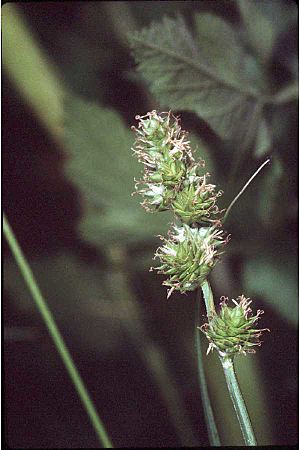Troublesome sedge facts for kids
Quick facts for kids Troublesome sedge |
|
|---|---|
 |
|
| Scientific classification | |
| Genus: |
Carex
|
| Species: |
molesta
|
Carex molesta, also known as the troublesome sedge, is a type of sedge plant. Sedges are grass-like plants, but they have solid, triangular stems, unlike grasses which usually have hollow, round stems. This plant is originally from eastern and central North America.
The troublesome sedge is very adaptable. It can grow well in many different places, from wet areas to dry spots. It also doesn't mind if it's in full sunlight or partial shade. You can often find it in places where the ground has been disturbed, like along roadsides. In California, it's considered an introduced species, meaning it was brought there from somewhere else, and it often grows like a weed.
This sedge grows in clumps, with its stems reaching up to about one meter (around 3 feet) tall. It has several thin leaves that can be up to 35 centimeters (about 14 inches) long. The plant produces a group of small, green, round flower clusters, each about 0.5 to 1.5 centimeters (0.2 to 0.6 inches) long. These clusters are called an inflorescence, which is just a fancy word for how flowers are arranged on a plant.
Contents
What is Troublesome Sedge?
The troublesome sedge is a plant that belongs to the Carex genus. This group of plants is very large, with thousands of different species found all over the world. Many sedges look like grasses, but they are different. One easy way to tell them apart is by feeling their stems. Grass stems are usually round and hollow, but sedge stems are often triangular and solid.
Where Does It Grow?
This plant is native to a large part of North America. You can find it growing naturally in the eastern and central regions of the continent. It's known for being very tough and able to grow in many different environments.
- Wet places: It can live near ponds, streams, or in marshy areas.
- Dry places: It also does well in drier soils.
- Sunny spots: Full sunlight is fine for this plant.
- Shady spots: It can also grow where there's only partial shade.
This ability to grow in so many different conditions makes it a very successful plant. It can even grow in places that have been changed by people, like the sides of roads or empty lots.
Why is it Called "Troublesome"?
The common name "troublesome sedge" comes from the fact that it can sometimes become a weed. In places like California, where it's not native, it can spread quickly. When a plant grows where it's not wanted, especially if it takes over space from other plants, it's called a weed. Because it's so good at growing in many different places, it can be hard to get rid of once it starts to spread.
Plant Features and Life Cycle
The troublesome sedge has some unique features that help it survive and reproduce. Understanding these features helps us learn more about the plant's life.
Stems and Leaves
The plant grows in a clump, meaning many stems grow close together from the same base. Each stem can reach up to about one meter tall. The leaves are long and narrow, like blades of grass, and can be up to 35 centimeters long. These leaves help the plant make its own food using sunlight, a process called photosynthesis.
Flowers and Seeds
The flowers of the troublesome sedge are very small and are grouped together in clusters. These clusters are called spikes. Each spike is green and shaped like a small ball, about 0.5 to 1.5 centimeters long. Several of these spikes grow together on a stem, forming what is known as an inflorescence. After the plant flowers, it produces seeds. These seeds are how the plant reproduces and spreads to new areas. The seeds can be carried by wind, water, or even animals, helping the plant colonize new habitats.
Images for kids


